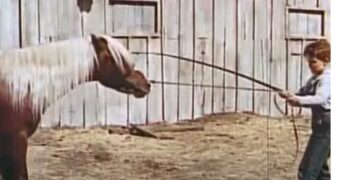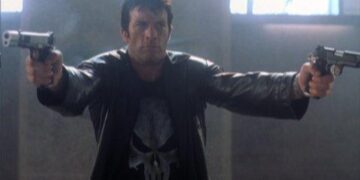Welcome, mystery enthusiasts, to a comprehensive guide to a classic gem in the crime thriller genre: Dick Tracy vs. Cueball.
In this article, we will delve into the fascinating world of Chester Gould’s creation, the 1946 film adaptation, and discover the behind-the-scenes insights and curiosities.
So, buckle up, because we are about to embark on a thrilling journey into the world of the iconic detective, Dick Tracy.
Comic summary: Chester Gould’s creation
Chester Gould created the iconic character, Dick Tracy, in 1931. The comic strip was published in newspapers around the United States, and it quickly gained a massive following.
With its unique combination of gritty crime stories, memorable villains, and cutting-edge technology, the comic strip stood out from other detective stories of the time.
In Dick Tracy vs. Cueball, we follow the famous detective as he takes on the cunning and ruthless criminal, Cueball.
The story is filled with suspense, action, and drama, making it a classic example of Chester Gould’s storytelling prowess. The comic strip features a gripping plot, superb artwork, and unforgettable characters, making it a must-read for any fan of crime fiction.
As the story unfolds, we see Dick Tracy not only battling Cueball but also struggling to maintain his personal life and relationships.
It is this mixture of action and emotion that has made the comic strip such a beloved classic.
Movie summary: The 1946 film adaptation
The 1946 film adaptation of Dick Tracy vs. Cueball brings Chester Gould’s creation to life on the big screen. Directed by Gordon Douglas, the movie stars Morgan Conway as the titular character, Dick Tracy, and Dick Wessel as the notorious villain, Cueball.
The film follows the basic plot of the comic strip, with some minor changes and additions. In the movie, Cueball is a ruthless criminal on a mission to steal a series of valuable diamonds. As the body count starts to rise, Dick Tracy is called in to solve the case and bring Cueball to justice.
The 1946 film adaptation is a fast-paced, action-packed thriller that captures the essence of the comic strip. With its dramatic plot, strong performances, and stylish visuals, the movie is a must-watch for fans of the original comic and crime thrillers alike.
When and where: setting and film locations
The film adaptation of Dick Tracy vs. Cueball is set in a fictionalized version of a big American city in the 1940s.
The comic strip, on the other hand, takes place in a more timeless setting, making it relevant even today. The movie was filmed in various locations around Los Angeles, including the iconic Bradbury Building.
This gave the film a unique and atmospheric feel, which contributed to its success.
Who’s who: character analysis
The characters in Dick Tracy vs. Cueball are some of the most memorable in the crime thriller genre.
The protagonist, Dick Tracy, is a tough, no-nonsense detective with a strong sense of justice. His dedication to his work often puts him at odds with his personal life, making him a complex and intriguing character.
Cueball, the main antagonist, is a cold and ruthless criminal with a penchant for violence. His cunning and resourcefulness make him a formidable opponent for Dick Tracy.
The movie also features a supporting cast of colorful characters, including Tracy’s love interest, Tess Trueheart, and his trusted sidekick, Pat Patton.
Memorable quotes from Dick Tracy vs. Cueball
The dialogue in both the comic strip and the movie is snappy and full of memorable quotes.
Some of the most iconic lines from the film include:
- “I’m on my way, and heaven help anyone who gets in my path.” – Dick Tracy
- “You can’t outsmart the law, Cueball. It always catches up with you.” – Dick Tracy
- “What’s the matter, copper? Afraid to face me?” – Cueball
Soundtrack by Phil Ohman: a musical overview
The soundtrack for Dick Tracy vs. Cueball was composed by Phil Ohman, a talented musician and composer.
The score adds a layer of tension and excitement to the film, perfectly capturing the mood of the story.
With its dramatic orchestral arrangements and memorable themes, the soundtrack is an essential part of the overall experience of watching the movie.
Parent guide: Is it suitable for children?
Although Dick Tracy vs. Cueball is a crime thriller, it is relatively tame by today’s standards. The film contains some violence, but it is not overly graphic or gory.
The movie may be suitable for older children and teenagers who can appreciate the story and visuals.
However, parents should use their discretion and consider their child’s maturity level before deciding if the movie is appropriate for them.
Tips for cosplay: dressing like your favorite characters
Dressing up as your favorite characters from Dick Tracy vs. Cueball can be a fun and creative way to express your love for the comic strip and movie. Here are some tips for creating a convincing cosplay:
- For Dick Tracy: Wear a yellow fedora and trench coat, along with a suit and tie. Add a wristwatch radio prop to complete the look.
- For Cueball: Dress in a dark suit, black gloves, and a black fedora. Add some menacing makeup to give yourself a sinister appearance.
- For Tess Trueheart: Wear a 1940s-style dress and hairstyle, and carry a stylish purse.
Chester Gould: a brief biography and works
Chester Gould was born in 1900 in Pawnee, Oklahoma, and is best known for creating the iconic comic strip, Dick Tracy.
He began his career as a cartoonist in the 1920s and continued to work on the comic strip until his retirement in 1977.
In addition to Dick Tracy, Gould also created several other comic strips, such as Radio Cattrall and The Complete Count of Monte Cristo.
Ending explained: dissecting the conclusion
The ending of Dick Tracy vs. Cueball is a thrilling and satisfying conclusion to the story. In both the comic strip and the movie, Dick Tracy finally catches up to Cueball and brings him to justice.
The climax is filled with action and suspense, as the two characters engage in a thrilling showdown.
Ultimately, it is Dick Tracy’s determination and resourcefulness that prevail, proving once again that no criminal can outsmart the legendary detective.
Remake, sequel, and spin-offs: the legacy of Dick Tracy vs. Cueball
The legacy of Dick Tracy vs. Cueball extends far beyond the comic strip and the 1946 film.
The story has been adapted and reimagined in various forms, including a 1990 film adaptation directed by Warren Beatty, which featured an all-star cast including Madonna and Al Pacino.
The movie was a critical and commercial success, and it brought the character of Dick Tracy to a new generation of fans.
In addition to the movies, there have been several TV series and animated adaptations of the Dick Tracy character, as well as comic book spin-offs and merchandise. The legacy of Dick Tracy vs. Cueball is a testament to the enduring appeal of the character and his world.
Other media by Gordon Douglas: exploring the director’s filmography
Gordon Douglas, the director of the 1946 film adaptation of Dick Tracy vs. Cueball, had a long and varied career in Hollywood.
He directed over 80 films, ranging from crime thrillers to musicals to westerns.
Some of his other notable works include Them!, a classic science fiction film about giant ants, and Kiss Tomorrow Goodbye, a gritty crime drama starring James Cagney.
Similar media to Dick Tracy vs. Cueball: recommendations for fans
If you are a fan of Dick Tracy vs. Cueball, there are several other media that you may enjoy. Here are some recommendations:
- Batman: The Dark Knight Returns by Frank Miller – This graphic novel features a similar mix of gritty crime and superhero action, with a dark and brooding tone.
- The Maltese Falcon by Dashiell Hammett – This classic crime novel features a tough and cynical detective, Sam Spade, and a cast of memorable characters.
- The Untouchables – This classic TV show and movie franchise follows the exploits of law enforcement officials in their fight against organized crime in Prohibition-era America.
Book club questions for discussion
If you are part of a book club or reading group, here are some questions to spark discussion about Dick Tracy vs. Cueball:
- Who is your favorite character in the story, and why?
- How does the setting of the story contribute to the overall atmosphere and mood?
- What themes or messages can be found in the story?
- How does the movie adaptation compare to the original comic strip?
- What elements of the story have aged well, and what elements feel dated?
Video game adaptations: bringing Dick Tracy vs. Cueball to interactive entertainment
Dick Tracy vs. Cueball has been adapted into several video games over the years, allowing fans to step into the shoes of the iconic detective and take on the criminal underworld.
Some notable video game adaptations include Dick Tracy for the NES and Dick Tracy: The Crime-Solving Adventure for PC.
Travel guide: visiting iconic Dick Tracy vs. Cueball locations
If you are a fan of Dick Tracy vs. Cueball, you may be interested in visiting some of the iconic locations featured in the story.
Here are some places to add to your travel itinerary:
- The Bradbury Building in Los Angeles – This historic building was one of the filming locations for the 1946 film adaptation of Dick Tracy vs. Cueball.
- Chicago, Illinois – The setting of the original comic strip is based on Chicago, and the city features several landmarks and locations that fans may recognize.
- Pawnee, Oklahoma – Chester Gould, the creator of Dick Tracy, was born in Pawnee, and the town has several tributes to the famous cartoonist.
Conclusion
Dick Tracy vs. Cueball is a classic example of the crime thriller genre, with its gripping plot, unforgettable characters, and stylish visuals.
Whether you are a fan of the original comic strip, the 1946 film adaptation, or the various spin-offs and adaptations, there is something for everyone in the world of Dick Tracy.
So, grab your yellow fedora and trench coat, and join us on a thrilling journey into the world of the iconic detective.














